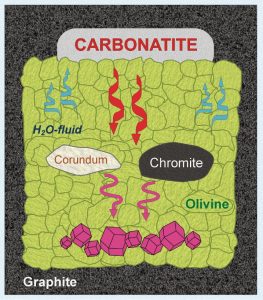 Newly performed experiments focused on formation of subcalcic Cr-rich garnet in the model ultramafic system corresponding to natural harzburgite with the presence of REE-bearing fluid phase. The experiments were carried out using a multi-anvil high-pressure apparatus at a pressure of 5 GPa and a temperature of 1300 °C. Natural serpentine, chromite, corundum and REE-carbonatite were used as starting components. Crystallization of garnet occurred in subsolidus conditions by the reaction of orthopyroxene and spinel in the presence of fluid phase. Composition of fluid was controlled by interaction of water released by decomposition of serpentine with carbonate. By using different amounts of carbonatite as a source of calcium and REE, subcalcic Cr-rich garnets were crystallized, which are typical for inclusions of harzburgitic paragenesis in natural diamonds. The experiments demonstrated that the REEs released from the initial carbonatite were transported by the fluid and were incorporated into the newly formed garnet. These results confirmed high partitioning of HREE into garnet. The present study indicates that the mantle carbonatites, which contain very high proportions of REE, can play an important role as source material in formation of REE-rich fluids to crystallize garnets with typical REE patterns in mantle peridotites.
Newly performed experiments focused on formation of subcalcic Cr-rich garnet in the model ultramafic system corresponding to natural harzburgite with the presence of REE-bearing fluid phase. The experiments were carried out using a multi-anvil high-pressure apparatus at a pressure of 5 GPa and a temperature of 1300 °C. Natural serpentine, chromite, corundum and REE-carbonatite were used as starting components. Crystallization of garnet occurred in subsolidus conditions by the reaction of orthopyroxene and spinel in the presence of fluid phase. Composition of fluid was controlled by interaction of water released by decomposition of serpentine with carbonate. By using different amounts of carbonatite as a source of calcium and REE, subcalcic Cr-rich garnets were crystallized, which are typical for inclusions of harzburgitic paragenesis in natural diamonds. The experiments demonstrated that the REEs released from the initial carbonatite were transported by the fluid and were incorporated into the newly formed garnet. These results confirmed high partitioning of HREE into garnet. The present study indicates that the mantle carbonatites, which contain very high proportions of REE, can play an important role as source material in formation of REE-rich fluids to crystallize garnets with typical REE patterns in mantle peridotites.
Chepurov A.A., Faryad S.W., Agashev A.M., Strnad L., Jedlička R., Turkin A.I., Mihaljevič M., Lin V.V. (2019): Experimental crystallization of a subcalcic Cr-rich pyrope in the presence of REE-bearing carbonatite. Chemical Geology 509, 103–114. (DOI)









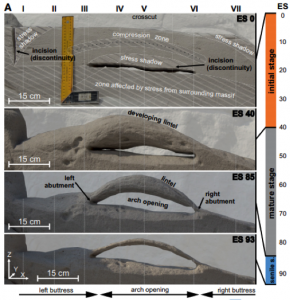 People tend to admire well-developed rock arches and bridges as a symbol of perfection in nature. However, the origin of such arches still remains unclear, with different authors emphasizing different factors as essential. An authentic small-scale physical model of a perfect arch was created in situ from friable sandstone through a simulation of natural erosion. Based on three-dimensional photogrammetric and numerical modeling, we established three evolutionary stages of the modeled arch: the initial, mature, and senile stages. Erosion removed the material from stress shadows, thus exposing the compressed zone of the material, which spans over the discontinuity. From its original lintel thickness with a length ratio of 0.3, the modeled arch thinned out to a ratio of 0.03, which is close to the best-developed natural arches. The erosion rate of the arch surface was relatively low for 90% of its lifespan, but the last 10% was characterized by an abrupt increase in the erosion rate. Our results show that the only conditions essential to producing a delicate arch through erosion are a thin, vertically elongated rock body with an appropriate discontinuity, and a material prone to stress-controlled erosion.
People tend to admire well-developed rock arches and bridges as a symbol of perfection in nature. However, the origin of such arches still remains unclear, with different authors emphasizing different factors as essential. An authentic small-scale physical model of a perfect arch was created in situ from friable sandstone through a simulation of natural erosion. Based on three-dimensional photogrammetric and numerical modeling, we established three evolutionary stages of the modeled arch: the initial, mature, and senile stages. Erosion removed the material from stress shadows, thus exposing the compressed zone of the material, which spans over the discontinuity. From its original lintel thickness with a length ratio of 0.3, the modeled arch thinned out to a ratio of 0.03, which is close to the best-developed natural arches. The erosion rate of the arch surface was relatively low for 90% of its lifespan, but the last 10% was characterized by an abrupt increase in the erosion rate. Our results show that the only conditions essential to producing a delicate arch through erosion are a thin, vertically elongated rock body with an appropriate discontinuity, and a material prone to stress-controlled erosion.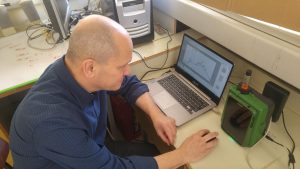 Discrimination of carotenoids in samples of carotene-producing microorganisms was carried-out using four miniature portable Raman spectrometers in a detailed comparison study. Two spectrometers using a green laser allowing to obtain Resonance Raman (or pre-Resonance Raman) signals, one instrument with a 785 nm laser, and a recently developed Portable Sequentially Shifted Excitation Raman spectrometer (PSSERS) were used for identifying major pigments of different halophilic (genera Halobacterium, Halorubrum, Haloarcula, Salinibacter, Ectothiorhodospira, Dunaliella) and non-halophilic microorganisms (Micrococcus luteus, Corynebacterium glutamicum). Using all the tested instruments including the PSSERS, strong carotenoids signals corresponding to the stretching vibrations in the polyene chain and in-plane rocking modes of the attached CH3 groups were found at the correct positions. Raman spectra of carotenoids can be obtained from different types of microbiological samples (wet pellets, lyophilized culture biomass and pigment extracts in organic solvents), and can be collected fast and without time-consuming procedures.
Discrimination of carotenoids in samples of carotene-producing microorganisms was carried-out using four miniature portable Raman spectrometers in a detailed comparison study. Two spectrometers using a green laser allowing to obtain Resonance Raman (or pre-Resonance Raman) signals, one instrument with a 785 nm laser, and a recently developed Portable Sequentially Shifted Excitation Raman spectrometer (PSSERS) were used for identifying major pigments of different halophilic (genera Halobacterium, Halorubrum, Haloarcula, Salinibacter, Ectothiorhodospira, Dunaliella) and non-halophilic microorganisms (Micrococcus luteus, Corynebacterium glutamicum). Using all the tested instruments including the PSSERS, strong carotenoids signals corresponding to the stretching vibrations in the polyene chain and in-plane rocking modes of the attached CH3 groups were found at the correct positions. Raman spectra of carotenoids can be obtained from different types of microbiological samples (wet pellets, lyophilized culture biomass and pigment extracts in organic solvents), and can be collected fast and without time-consuming procedures.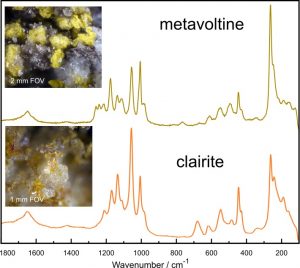 This study focuses on the investigation of three uncommon complex iron sulfates – clairite, metavoltine, and voltaite – using Raman spectroscopy. The investigated specimens were formed at the burning coal dump Anna I (Alsdorf, Germany) due to alteration processes connected with the subsurface thermal activity. The results demonstrate proliferation of Raman bands and extraordinary strong spectral features connected with the specific crystal structures of these minerals. These data obtained here can serve as the reference material for the investigation of sulfate encrustation of fumarolic sulfide-weathering origin as well as can be implemented into the mineral databases important for the geological and mineralogical exploration of other extraterrestrial bodies.
This study focuses on the investigation of three uncommon complex iron sulfates – clairite, metavoltine, and voltaite – using Raman spectroscopy. The investigated specimens were formed at the burning coal dump Anna I (Alsdorf, Germany) due to alteration processes connected with the subsurface thermal activity. The results demonstrate proliferation of Raman bands and extraordinary strong spectral features connected with the specific crystal structures of these minerals. These data obtained here can serve as the reference material for the investigation of sulfate encrustation of fumarolic sulfide-weathering origin as well as can be implemented into the mineral databases important for the geological and mineralogical exploration of other extraterrestrial bodies.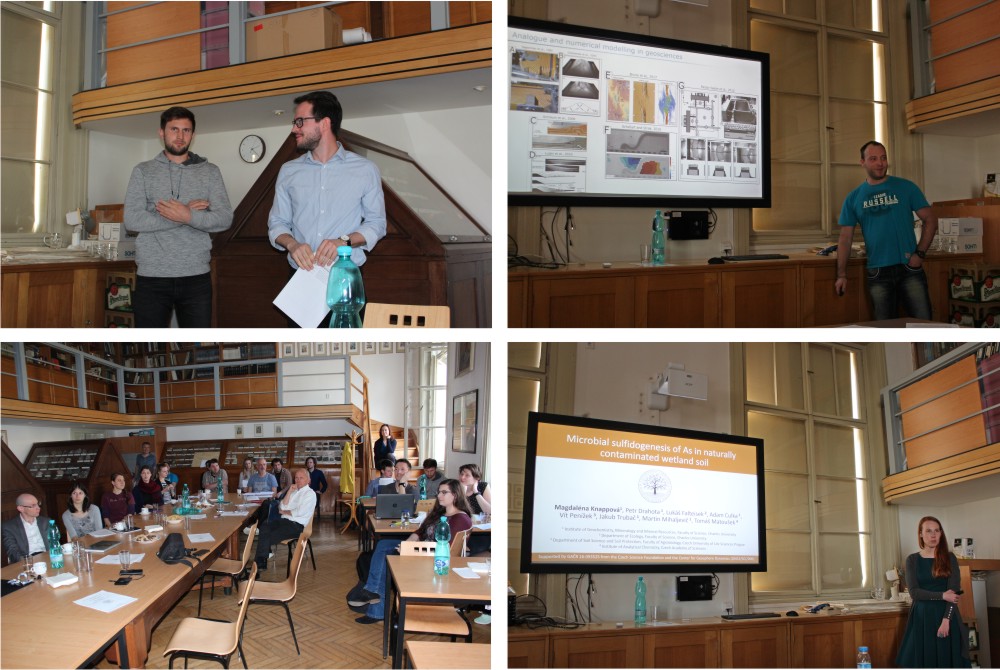 On April 4, 2019, the PhD students associated to the Center of Geosphere Dynamics organized a very successful PhD conference, where they presented results of their research projects. The program is available
On April 4, 2019, the PhD students associated to the Center of Geosphere Dynamics organized a very successful PhD conference, where they presented results of their research projects. The program is available  Thanks to financial support from the Center, we established a brand new lab focused on analogue tectonic experiments. The lab is equipped with highly sophisticated apparatus purpose-made by the Development Center of the Institute of Organic Chemistry and Biochemistry, Czech Academy of Sciences, which will be able to simulate a wide range of geologic processes, mostly related to active continental margins and subduction of oceanic plates.
Thanks to financial support from the Center, we established a brand new lab focused on analogue tectonic experiments. The lab is equipped with highly sophisticated apparatus purpose-made by the Development Center of the Institute of Organic Chemistry and Biochemistry, Czech Academy of Sciences, which will be able to simulate a wide range of geologic processes, mostly related to active continental margins and subduction of oceanic plates.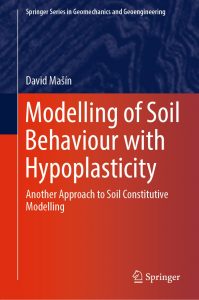 A new book by Dr. David Mašín, a senior researcher of the Center, devoted to hypoplastic modelling framework and entitled „Modelling of Soil Behaviour with Hypoplasticity: Another Approach to Soil Constitutive Modelling“ has just been published by Springer (
A new book by Dr. David Mašín, a senior researcher of the Center, devoted to hypoplastic modelling framework and entitled „Modelling of Soil Behaviour with Hypoplasticity: Another Approach to Soil Constitutive Modelling“ has just been published by Springer ( Vesmír journal interviewed a member of our Center, prof. Tomáš Cajthaml, about contamination of the environment by organopollutants and micropollutants. The whole text (in Czech) entitled “Compost is a microbiological museum” can be found
Vesmír journal interviewed a member of our Center, prof. Tomáš Cajthaml, about contamination of the environment by organopollutants and micropollutants. The whole text (in Czech) entitled “Compost is a microbiological museum” can be found 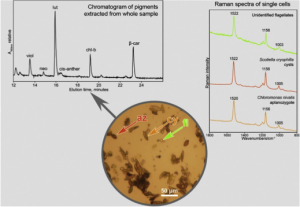 The potential of Raman microspectroscopy for the determination of carotenoid pigments (both primary: lutein, beta-carotene, and secondary: astaxanthin carotenoids) in the different species and life-cycle stages of snow algae from the order Chlamydomonadales (Chlorophyta) was tested alongside a comparison of a reference method of biological pigment analysis: high-performance liquid chromatography. The three main carotenoid Raman bands of the astaxanthin-rich red cysts were located at 1520, 1156 and 1006 cm−1. The shifts (orange aplanozygotes and green motile cells with flagella) in the position of the ν1(C=C) Raman band of the polyenic chain is consistent with the expected changes in the ratios of the various carotenoid pigments. Flagellated green cells commonly contain lutein as a major carotenoid, together with minor amounts of β carotene and varying amounts of antheraxanthin, violaxanthin and neoxanthin. Aplanozygotes contain mixtures of both primary and secondary carotenoids. In most cases, the ν1(C=C) band is an overlapping set of bands, which is due to the signal of all carotenoid pigments in the sample, and a deconvolution along with the band position shifts (mainly ν1) could be used to characterize the mixture of carotenoids.
The potential of Raman microspectroscopy for the determination of carotenoid pigments (both primary: lutein, beta-carotene, and secondary: astaxanthin carotenoids) in the different species and life-cycle stages of snow algae from the order Chlamydomonadales (Chlorophyta) was tested alongside a comparison of a reference method of biological pigment analysis: high-performance liquid chromatography. The three main carotenoid Raman bands of the astaxanthin-rich red cysts were located at 1520, 1156 and 1006 cm−1. The shifts (orange aplanozygotes and green motile cells with flagella) in the position of the ν1(C=C) Raman band of the polyenic chain is consistent with the expected changes in the ratios of the various carotenoid pigments. Flagellated green cells commonly contain lutein as a major carotenoid, together with minor amounts of β carotene and varying amounts of antheraxanthin, violaxanthin and neoxanthin. Aplanozygotes contain mixtures of both primary and secondary carotenoids. In most cases, the ν1(C=C) band is an overlapping set of bands, which is due to the signal of all carotenoid pigments in the sample, and a deconvolution along with the band position shifts (mainly ν1) could be used to characterize the mixture of carotenoids.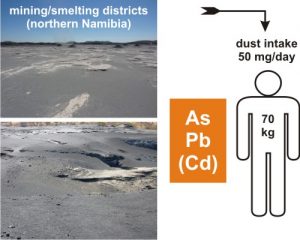 We used a multi-method approach for characterization of dust from mines and smelters in the northern Namibia. In vitro bioaccessibility testing in simulated gastric fluid (SGF) indicated that As, Pb (and also Cd to a lesser extent) exceeded tolerable daily intake limits for these contaminants in the case of slags and smelter dusts, but the exposure risk for local population is only important at the unfenced disposal sites.
We used a multi-method approach for characterization of dust from mines and smelters in the northern Namibia. In vitro bioaccessibility testing in simulated gastric fluid (SGF) indicated that As, Pb (and also Cd to a lesser extent) exceeded tolerable daily intake limits for these contaminants in the case of slags and smelter dusts, but the exposure risk for local population is only important at the unfenced disposal sites.